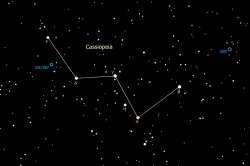Shimmering 'super-Earth' in constellation Cassiopeia discovered
Located 21 light years away from us, this planet, dubbed HD219134 b, has a mass almost five times that of Earth, which is considered a so-called "super-Earth".

Researchers have discovered a new exotic planet outside our solar system in the constellation Cassiopeia.
Located 21 light years away from us, this planet, dubbed HD219134 b, has a mass almost five times that of Earth, which is considered a so-called "super-Earth".
Unlike the Earth, however, it most likely does not have a massive core of iron, but is rich in calcium and aluminium alongside magnesium and silicon.
"This is why such planets cannot, for example, have a magnetic field like the Earth," said one of the researchers Caroline Dorn, astrophysicist at the University of Zurich in Switzerland.
And because the inner structure is so different, their cooling behaviour and atmospheres will also differ from those of normal super-Earths.
"Perhaps it shimmers red to blue like rubies and sapphires, because these gemstones are aluminium oxides which are common on the exoplanet," said Dorn.
HD219134 b is one of three candidates likely to belong to a new exotic class of exoplanets, say the researchers, according to the study published in the journal Monthly Notices of the Royal Astronomical Society: Letters.
The other two exoplanets studied, 55 Cancri e and WASP-47 e, orbit their star so closely that their surface temperature is almost 3000 degrees.
"So, we have found three candidates that belong to a new class of super-Earths with this exotic composition," the researchers said.